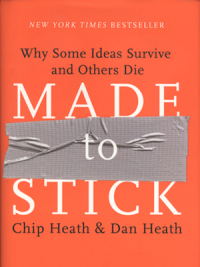

In Made to Stick, Chip and Dan Heath reveal the anatomy of ideas that stick and explain ways to make ideas stickier, such as applying the human scale principle, using the Velcro Theory of Memory, and creating curiosity gaps. Meanwhile, people with important ideas-entrepreneurs, teachers, politicians, and journalists-struggle to make them “stick.” Mark Twain once observed, “A lie can get halfway around the world before the truth can even get its boots on.” His observation rings true: Urban legends, conspiracy theories, and bogus news stories circulate effortlessly.

Made to Stick is informative and entertaining at the same time, but I’m not sure how useful it will be in practical application. Similar to Malcolm Gladwell or Charles Duhigg, the Heath brothers use interesting anecdotes to illustrate the concepts of stickiness. Provocative, eye-opening, and often surprisingly funny, Made to Stick shows us the vital principles of winning ideas–and tells us how we can apply these rules to making our own messages stick.Why do some ideas stick – no matter how true – while others go in one ear and out the other? Chip and Dan Heath break down the elements that made ideas memorable and teach you how to create stickier messaging. It’s a fast-paced tour of success stories (and failures): the Nobel Prize-winning scientist who drank a glass of bacteria to prove a point about stomach ulcers the charities who make use of the Mother Teresa Effect the elementary-school teacher whose simulation actually prevented racial prejudice. Made to Stick will transform the way you communicate. Along the way, we discover that sticky messages of all kinds–from the infamous “kidney theft ring” hoax to a coach’s lessons on sportsmanship to a vision for a new product at Sony–draw their power from the same six traits. Meanwhile, people with important ideas–entrepreneurs, teachers, politicians, and journalists–struggle to make them “stick.”


 0 kommentar(er)
0 kommentar(er)
